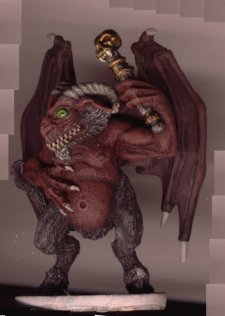
This is the most basic type of painting style. The miniature is primered in a light gray or white and then its base colors are applied followed by a wash (if necessary) and then a drybrush. You may either work section at a time (best if working on a whole unit at once) or do all sections simultaneously. Either way you will inevitably have to go back and touch-up the areas where you slopped a bit. While I said it was the most basic, it is by no means the easiest. It does offer the brightest colors and the best quality (when done correctly).
D1GMT - Drybrush Once, Glaze Many Times
This is a far easier method. Although it cannot be used for caucasian skin, it works pretty well with most other things. The miniature is primered in black. The a first, heavy drybrush of medium gray is applied, followed by a light drybrush of light gray or white. Then the colors (mostly ink but sometimes paint) is applied by glazing (see basic skills page) over the monochrome drybrush. The resulting paint job will not have eye popping color. It will be somewhat subdued. But gives a pretty fair result in a very small amount of time. I find that I have less touch ups with this method, but I have to go back and paint the metals black or dark brown before drybrushing them with metallic paint.
Blacklining
This is a simple way to hide slight flaws in the boarders between colors
while giving more contrast to the figure. I think it often makes the figure
more cartoonish looking, and less realistic. But that's often what people
like. It consists simply of painting a thin black line between each color
(section). Each part of the figure stands out more, and the tiny, tiny
slop marks on certian boarders can be hidden.
Back to Tools Back to Basic Skills Back to Home
e-mail the author: [email protected]

